|
What are carbon credits, and what is the carbon credit ecosystem? Co-authored by Klimacap
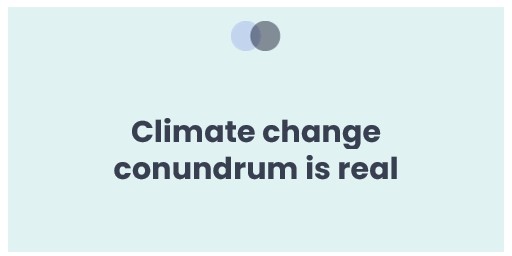
"Carbon credits" are a measure of carbon dioxide (CO2), where one unit represents 1 ton of CO2 avoided or removed from the atmosphere.
Over the past few years, the urgency of climate issues has significantly driven the development of carbon markets: companies have been increasingly regulated on their carbon footprints. If a company's carbon footprint exceeds its emissions cap as dictated by its national cap-and-trade program, it must purchase "carbon credits" to offset excess emissions and meet their regulatory requirements.
Once acquired, carbon credits can in turn be traded until they are used or retired by an end user.
A visual overview of the Carbon Credits Ecosystem
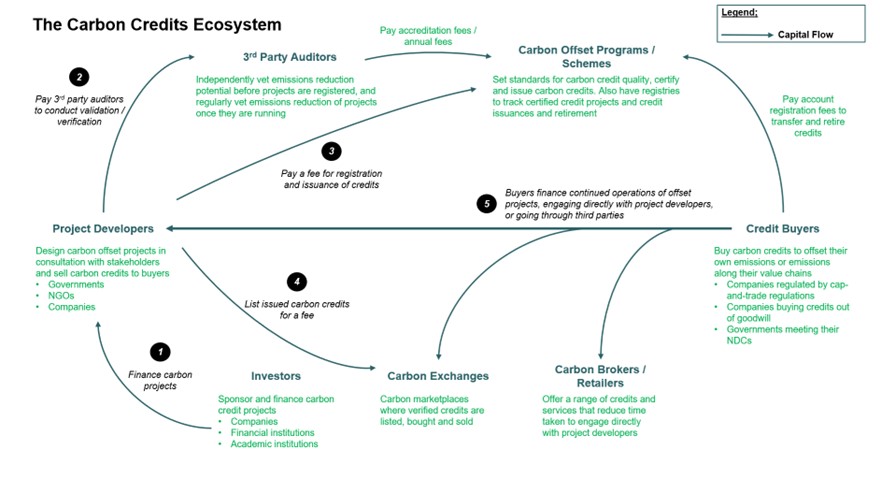
Sources: Paia, Klimacap Analysis Carbon Credits as an Asset Class
Carbon credits represent a relatively new type of investment where investors would look for returns through the potential increase in carbon credit prices. Carbon credits can also be considered a socially responsible investment that supports sustainable practices and the reduction of greenhouse gas emissions.
Types of Carbon Credits, Generation and Markets 
Source: Klimacap Analysis
Understanding carbon credits, and how they are generated. Carbon credits (offsets) are broadly classified into (1) avoidance: obtained by reducing or avoiding future carbon emissions, and (2) removal: obtained by removing carbon present in the atmosphere. These are generated from a variety of projects revolving around land and energy use, including returning biomass to the soil / carbon capture and storage technologies. Such projects are typically verified by third-party organizations to ensure that they meet certain environmental and social standards to be eligible for carbon credits.
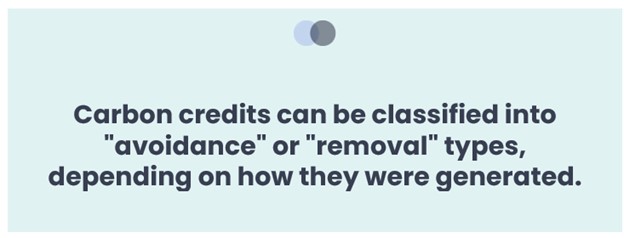
Differentiating between the value of a carbon removal credit, and a carbon avoidance credit The value of carbon credits depends on various factors, such as the type of project, the quality of the credits, and market demand. In general, carbon removal credits are considered more valuable than carbon avoidance credits because they directly remove carbon dioxide or other greenhouse gases from the atmosphere. 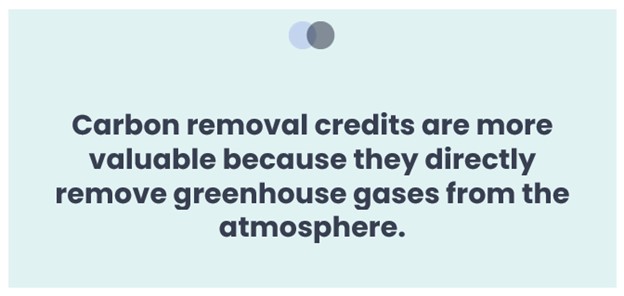
Trading carbon credits: voluntary vs. compliance carbon markets Carbon credits can primarily be traded via two markets:
Understanding the growth trajectories in VCM vs. CCM A McKinsey report estimates that the CCM market is valued at about $100 billion worldwide, with the estimated annual trading turnover of about $250 billion. These are driven entirely by regulatory actions and there are more than 20 such markets globally, and more to come online soon.
In contrast, the VCM market is still nascent and small, with a total value of about $300 million today but expected to grow significantly. According to McKinsey, global demand for voluntary carbon credits is expected to increase fifteenfold (15x) by 2030 and a hundredfold (100x) by 2050. Overall, depending on different price scenarios and underlying drivers, the market size in 2030 could be between $5 - $30 billion at the low end and more than $50 billion at the high end.
Because a carbon credit can be resold repeatedly until it has been used/retired by an end-user seeking to offset their carbon footprint, companies have acquired VCM credits as part of their efforts to achieve net-zero goals, or even net-carbon negative commitments.
Potential global demand for voluntary carbon credits
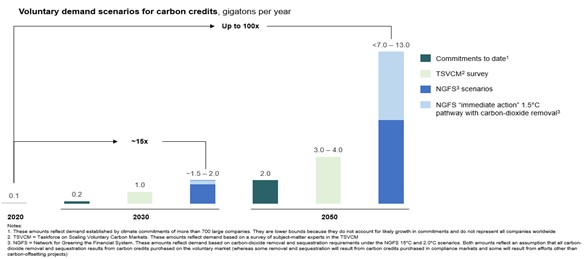
Source: McKinsey
The potential in the carbon credit market
Carbon credit prices are projected to rise in the medium to long-term, consequent to growing demand for and a tightening supply of high-quality carbon credits. There are 3 main drivers for carbon credit demand:
Additionally, demand for more costly, high-quality credits will continue to rise as quality remains the most important consideration for end-users. Under Bloomberg’s bifurcation scenario, where the carbon credit market is categorised based on carbon credit quality, the price for high-quality credits is projected to grow from 2023 to 2039 as the supply of carbon credits is unlikely to keep up with demand.
Weighing the benefits of investing in carbon credits, against their risks
The mix of credits in a portfolio is an important consideration: not all carbon credit generation projects are considered equal, with some having higher prices. As an example, reforestation projects which convert barren land into virgin forest will increase global carbon absorption. Furthermore, younger growing trees consume more fuel and absorb more carbon than mature ones. As a result, these projects tend to generate the highest quality/price credits.
On the other hand, renewables-based credits are often considered lower quality and are associated with a lower price as the true displacement of fossil fuel is open to interpretation.
Notable benefits to having carbon credits in an investment portfolio include:
Accordingly, it is imperative to note the risks associated with investing in carbon credits:
Greenwashing is also a risk when investing in carbon credits. This occurs when companies or organizations falsely claim to be environmentally responsible in order to gain public approval or financial benefits.
How to access to carbon credit investments In the public markets, there are a variety of direct and indirect ways to seek exposure:
On the private market side, investors may access carbon projects that may otherwise not listed on the above public markets, as well as invest in climate-related start-ups across the ecosystem.
Ultimately, whether carbon credits are a good investment opportunity for an individual or organization depends on their specific investment goals and risk tolerance. Careful research and due diligence are important before investing in any market, including the carbon credits market. Further, participating in the nascent carbon markets, should be considered as a long-term investment strategy, and should not be relied upon for short term gains.
|
This website is meant for viewing only. To place order please go to www.dollardex.com
